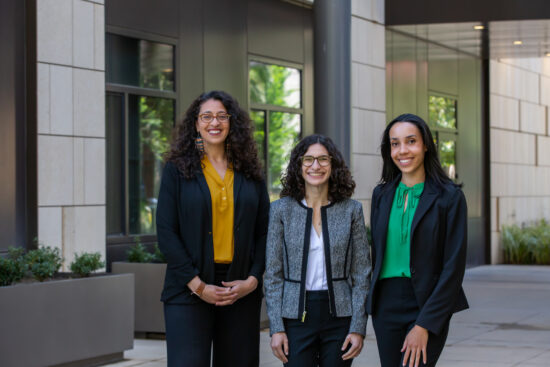Immigrants’ Rights Clinic Students Reflect on First Court Hearing
Lauryn Bennett, ’24, on Preparing for the Hearing:

This quarter, my clinic partner and I represented a Venezuelan family seeking asylum at their virtual court hearing. Going into the hearing, I felt much calmer than I anticipated feeling at the beginning of the quarter. While I expected to feel nervous once our client and her children arrived, or once we walked into the room for the hearing, or once the Webex launched, I did not feel nervous at any of these intervals. Looking back, I realize that I felt so calm because of how much my clinic partner and I had prepared in advance. We had observed the judge via WebEx during hearings weeks before, drafted several iterations of our hearing outline, mooted multiple times with our clinic supervisor and in front of the class – practicing all of the worst-case scenarios, and had thoroughly discussed many of the possibilities with our clients before the hearing to know how they would prefer we proceed. Because we had spent the last few weeks practicing and preparing for so many possibilities, I felt well-versed in the facts we would need to get across for any of the scenarios. More importantly, after a thorough conversation with our clients regarding their preferences for the outcome of the hearing, I felt confident in what to say and how to interact with the Judge and the DHS attorney to best respect our clients’ wishes. As such, as the hearing began, I felt confident that we would be able to serve as good advocates for our clients no matter what situations might arise.
Luckily, none of the worst-case scenarios ended up arising during the hearing. The judge was understanding of our requests and patient with us when we needed to confer with our supervisor during parts of the hearing. I was also calmed by the fact that I had watched my clinic partner prepare alongside me for the past few weeks, so I was confident that she would be able to adeptly navigate our requests to the judge.

Looking back, I would not have changed anything about our preparation. We were well prepared for multiple different scenarios which gave me a greater understanding and appreciation for how certain facts of their case and decisions interacted. In turn, this made me feel that I had a better command of their entire case walking into the hearing which allowed me to approach the conversation with confidence and a calm frame of mind.
Ari Berman, ’24, on Cultural Humility:
Although Lauryn and I were thrilled by the hearing and how it was progressing in real-time, I noticed that the hearing was having a different effect on our client, who is a monolingual Spanish-speaker. Despite the entire hearing centering on her pleadings, case, and timeline, she didn’t know what was going on in real-time due to the language barrier. We waived simultaneous interpretation, and many of our conversations were off the record. I tried to draw a little smiley face for our client and whisper that everything was fine and going well, but I was not sure if this was reassuring or if the smiley face came across as a reminder to smile. During the hearing, the judge asked to see her minor children so that he could waive their appearance at future hearings. While we understood the judge’s request and knew it was standard, our client seemed confused and concerned at the request. I can imagine that our client may have also thought something was wrong during moments when we paused to confer with our supervisor. For most of the conversation, all our client had to assess how the hearing was going were our facial expressions and the judge’s tone. Even this was likely disorienting, since the tone in court hearings can be monotone. While we smiled at our client throughout the hearing, the difference in our effect and the judge’s effect may have added to the stress of the situation.
Even though we had prepared our client for the back-and-forth logistical conversations we would have with the judge, I think applying a cultural humility lens into future hearings will help calm the client.
This experience has made me think more globally about the need for cultural humility in the immigration system, which has been built for lawyers, not clients. The fact that simultaneous interpretation can be waived for clients further distances the client from the judge, instead centering the lawyer-judge relationship. The lawyer-judge relationship is furthered by the fact that most questions are directed to the lawyer, and not the client. A virtual court hearing can also feel distant and bureaucratic when everything is through a screen.
I also believe that cultural humility can be applied in the explanation of the proceedings by the court. When we observed the court hearings of unrepresented seekers a few weeks earlier, I noticed a few procedures were explained to them but not what kinds of questions would be asked and what the next steps would be following the hearing. Approaching the hearing through a cultural humility lens can make court hearings more approachable for asylum seekers.
